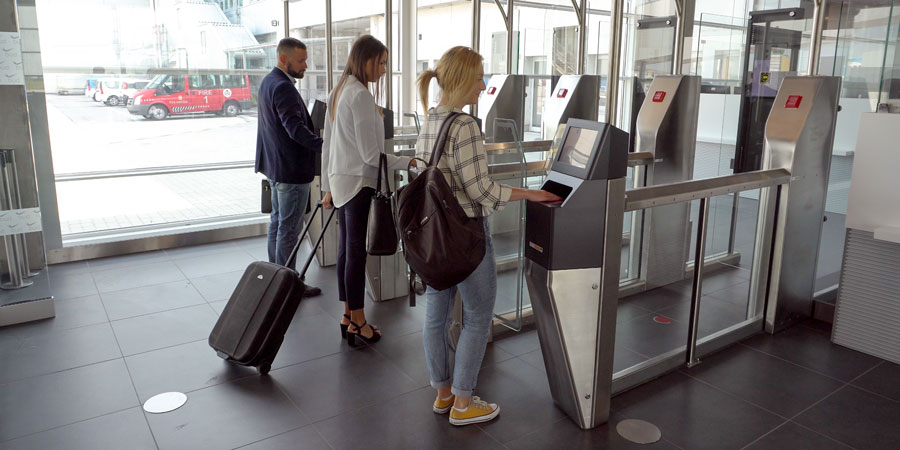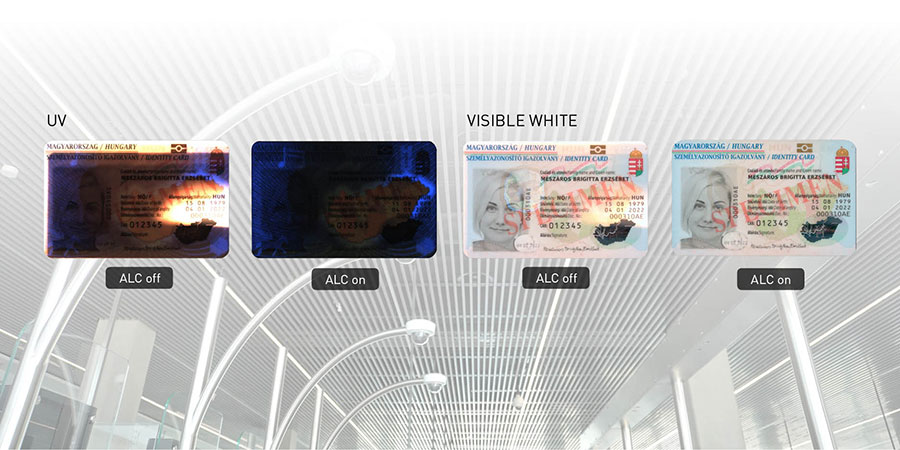Hassle-free border control at Budapest Airport
| Company | Adaptive Recognition |
|---|---|
| Date | 14.02.2022 |
 To cope with the impressive growth of traffic and to streamline the identification process of passengers, Adaptive Recognition has installed e-gates at Ferenc Liszt International Airport.
To cope with the impressive growth of traffic and to streamline the identification process of passengers, Adaptive Recognition has installed e-gates at Ferenc Liszt International Airport.
Quick project facts
- Locations: Budapest Ferenc Liszt International Airport, Debrecen Airport, Hungary
- Product: Complete e-gate with Combo Smart Kiosk e-passport reader
- Quantity: 12 gates (Budapest), 2 gates (Debrecen)
- Year of installation: 2019
- Application area: Automated Border Control
- Adaptive Recognition Partner: secunet
In 2018, 14.8 million passengers were handled at Budapest Ferenc Liszt International Airport – a double-digit growth from the previous year. To cope with the impressive growth of traffic and to streamline the identification process of passengers, Adaptive Recognition has installed e-gates at Ferenc Liszt International Airport and Debrecen International Airport, incorporating field-tested solutions by industry partner secunet.
The challenge
For many passengers arriving from outside the Schengen area, Hungary is the gateway to Europe – in this sense, Budapest is responsible for the safety and security of half a billion EU citizens. As international tourism is living its heyday, maintaining the borders secure and ensuring smooth passenger flow at the same time, was a real pursuit of complexity.
Joining forces with field-tested solutions by secunet, Adaptive Recognition installed ABC (Automated Border Control) gates at Ferenc Liszt International Airport and Debrecen International Airport.
The solution
E-gates, or Automated Border Control gates can massively reduce the security-related workload of border control agencies, while offering automated identity verification based on the passengers’ travel documents and their biometric data. As border guards’ do not need to perform hundreds of passport checks, they can better focus on the passengers, on the personal identification and on the overall security of the border control procedure, while the self-service system can quickly and securely process the travelers.
The key components of the ABC gate – passport scanner, live face recognition system, and physical access control – makes border crossing faster and more efficient. On average, the 2-step identity verification process takes 15 seconds per an average passenger, but those who have used the gate before and have some experience, the time reduces to even 10-12 seconds.
Thanks to simultaneous processing, the system can work even faster than that, as the next passenger can already start the process while the previous person is still in progress (still inside the gate). As a result, a 4-gate ABC unit can process 24 persons in a minute – which also means taking a full Airbus A320 flight in less than 8 minutes!

The process of Automated Border Control
- The passenger scans the identity document on the self-service terminal. The ID document scanner device automatically captures printed and digital (RFID) data, including face photograph. At the same time, it performs forgery detection and filters out any fake or copied IDs. The system gives guidance on how to place the document correctly and provides feedback with assistance when the ID is place incorrectly. Once the scanning is completed, the passenger steps in the e-gate where the face recognition terminal takes a photo of the traveller. At the same time, the extracted data is cross-checked with national and international databases for law enforcement purposes.
- The system makes a face verification check, comparing the photo from the ID and the live face photograph. At the same time, the backend system, connected to national and international ID databases, runs a cross-check analysis.
- Once it is completed, the gate opens – the passenger can pass through and the border control is completed.
- During the whole process, the overview camera system monitors what is happening, this way ensuring the appropriate use of the gates.
A closer look of the passport reader
The passport reader device, integrated in the outer kiosk is developed by Adaptive Recognition Hungary Inc., model: Combo Smart Kiosk. This unit is a professional ID verification tool, including several features designed for e-gate usage, such as:
- rectangular design and mounting points for built-in purposes
- automatic motion detection (user just places the document and it automatically starts scanning),
- Adaptive Light Control (the reader compensates for any external light)
- BSI-compatible RFID reading system (contactless chip reading according to the highest industry standards).
Find out more about Combo Smart Kiosk:
Adaptive Light Control feature
See how external light interference is filtered out by the outstanding Adaptive Light Control function:

What benefits such system brings
- For the airport
Seamless passenger flow, reduced workload and cost-effective automatic operation 24/7 are great advantages for the company running the air terminal. Automated Border Control is a scalable solution: e-gates can be flexibly multiplied as passenger numbers grow – without having to change floor plan or immigration workflow. In a race for airlines and travellers, terminals with ABC gates can improve user experience and keep growing.
- For the government
Thorough screening of passengers is done automatically. Identity verification – comparing the digital facial image captured from on-site photo to the optical and digital extracted data from the travel document – is fast and secure. The system acts as a power tool for border control officers, who can concentrate on the few problem cases.
- For the passengers
Just like self-service checkouts in retail stores, ABC gates streamline the border crossing process for the passengers, who will learn to use the gates intuitively by following the example of fellow passengers.
About the project participants
Adaptive Recognition
As an innovative market leader, Adaptive Recognition designs and delivers purpose-made ID scanners and passport readers that can read ALL identity documents in the word. Adaptive Recognition passport readers extract both printed and electronic data from official travel documents and national IDs. A technologically more challenging task is detecting fake, forged or tampered ID documents – a process called verification or authentication.
Adaptive Recognition passport readers perform document authentication by checking data integrity: comparing the captured printed and electronic information in compliance with the latest and most advanced e-passport standards.
Adaptive Recognition’s ID document readers offer trusted, high-quality solutions and they are widely used all over the world in mission critical homeland security and border control deployments as well as in airline check-in systems, know-your customer schemes and hotel guest registration applications.
secunet
At secunet, more than 400 experts focus on cryptography (SINA), e- government, business security and automotive security, with services ranging from analysis to consulting, conception, development and integration of software and hardware solutions to training and support.
Over the last two decades, secunet has emerged as an innovative market leader in Germany and Europe, offering solutions and products in fields like applied cryptography, e-Government, business security and automotive security.
Budapest Ferenc Liszt Airport
Learn more through the airport’s website.
More information
- Project video
- Adaptive Recognition passport readers




